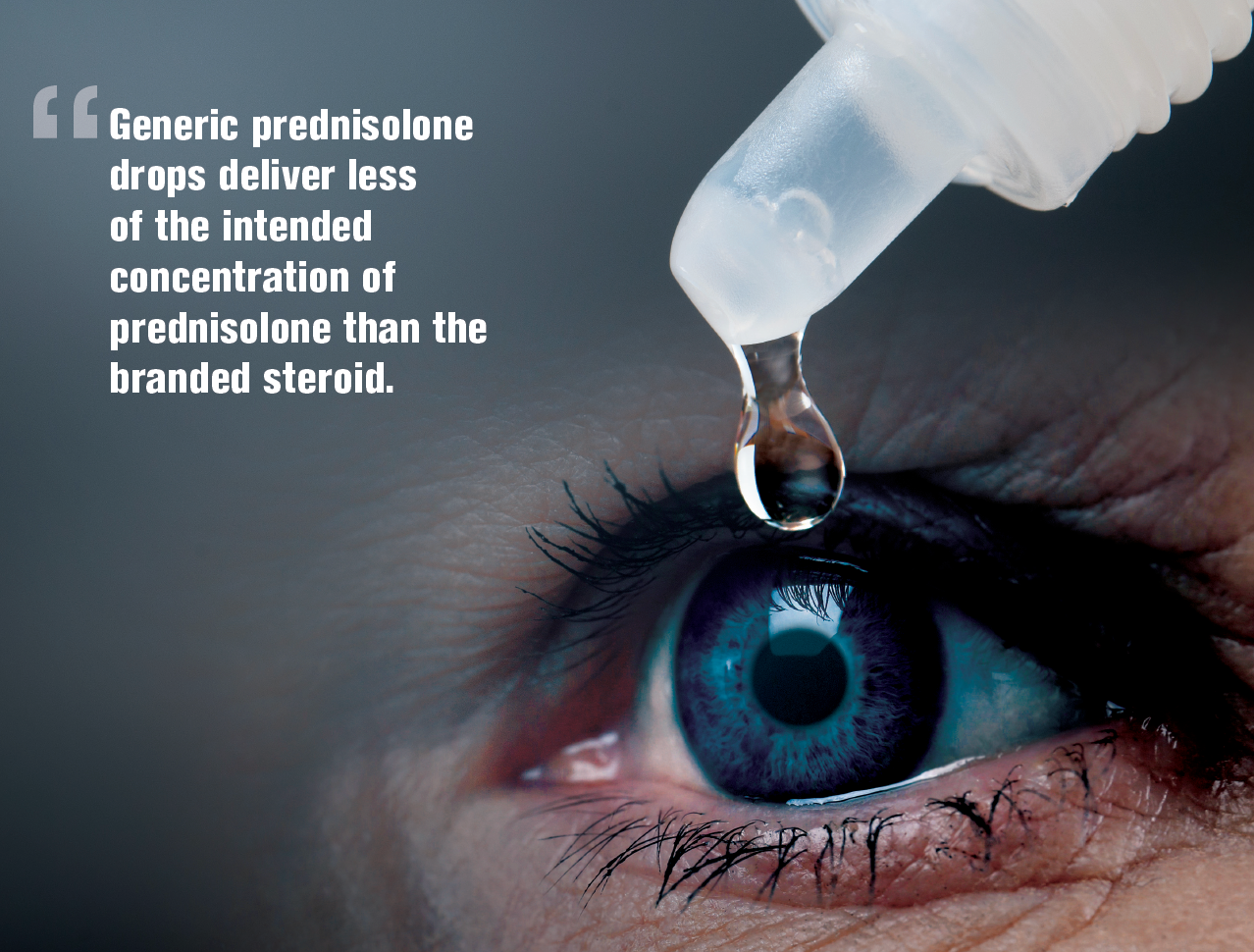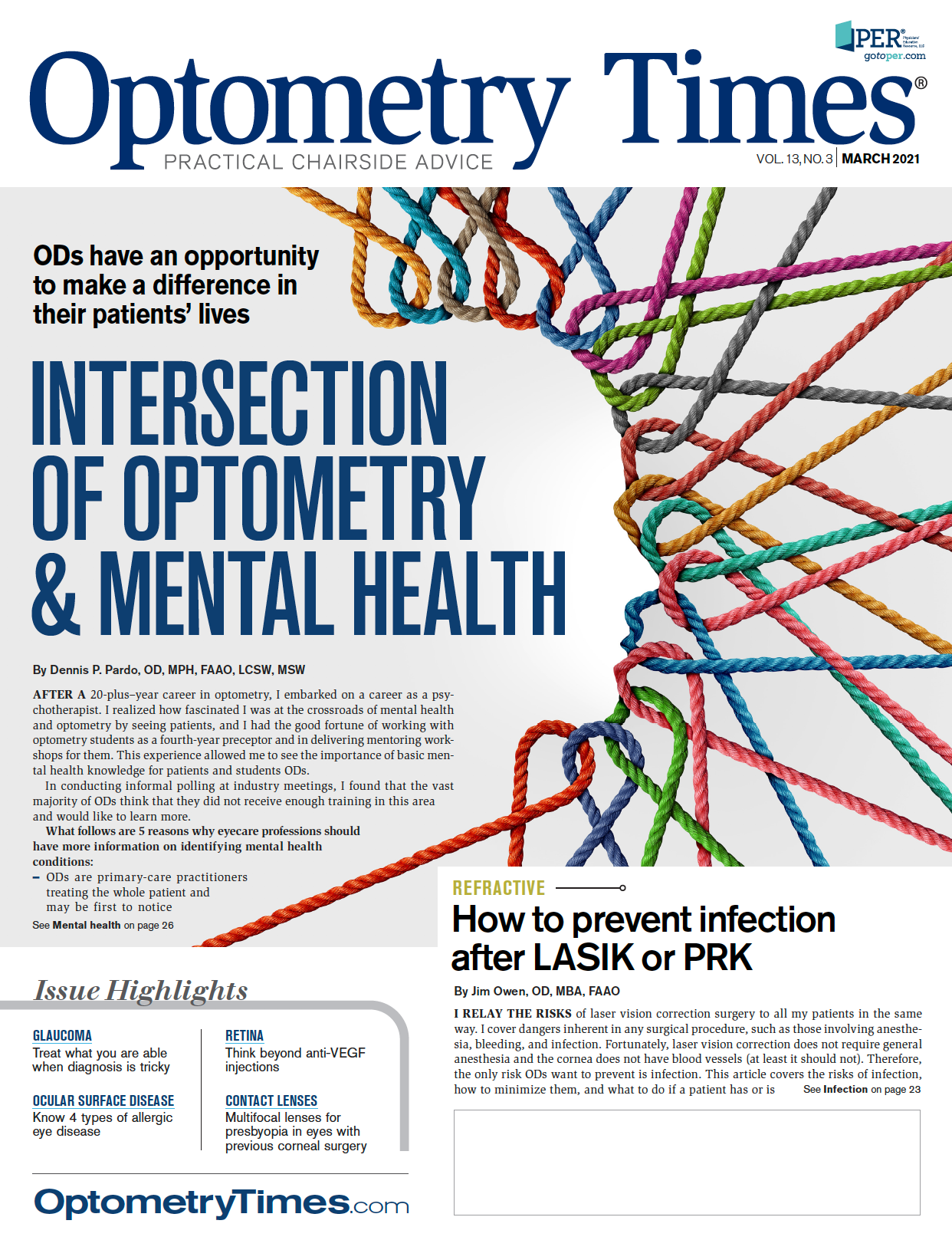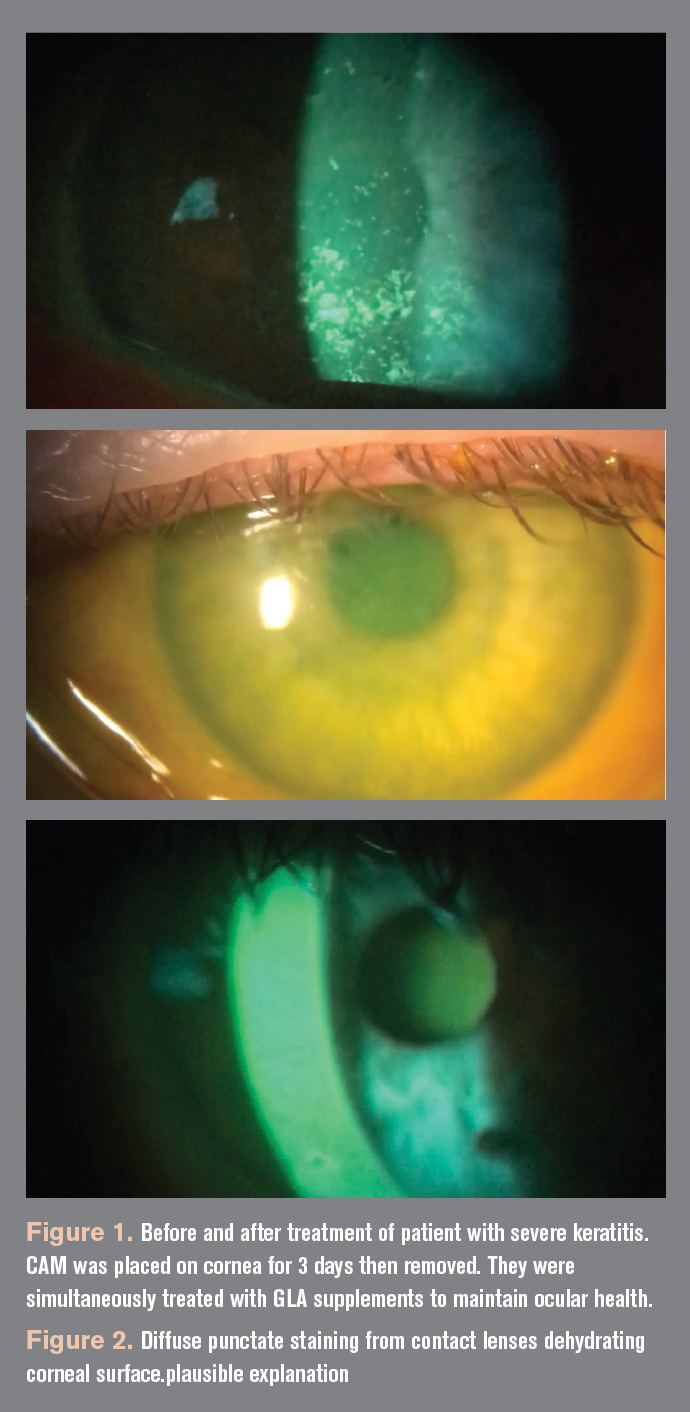Know risks and benefits of ocular steroid use
Ophthalmic corticosteroids optimize outcomes in patients with ocular inflammatory conditions


Brujic, PharmD
Ophthalmic corticosteroids provide ODs with the opportunity to treat complex ocular conditions. Conditions that are rooted in inflammation and require acute alleviation respond well to corticosteroids.
Steroids have been embraced as postoperative therapy, in particular cataract surgery, to manage both pain and inflammation. Additionally, several conditions including dry eye, lid inflammation, allergic conjunctivitis, non-infectious infiltrative keratitis, and anterior uveitis, can benefit from temporary use of a topical corticosteroid. Although the information included in this article is not a comprehensive list of all indications for topical corticosteroids, conditions that would benefit from inflammation reduction may benefit from topical corticosteroids.
Risks of use
It is important to understand the risks with topical corticosteroid use. Corticosteroids can increase intraocular pressure (IOP), so it is critically important for practitioners to regularly assess IOPs while patients are using topical corticosteroids.
Although corticosteroids are frequently used on a short-term basis and then discontinued after the ocular condition is alleviated, it is critical to manage IOP elevations during treatment if the corticosteroid cannot be discontinued. This can be effectively performed by temporarily adding a topical ocular hypotensive agent that is not a prostaglandin analogue.1,2
Additionally, patients who may require long-term corticosteroid therapy, such as corneal transplant patients, need to be monitored and managed if IOP elevates. Long-term corticosteroid use also increases the risk of developing posterior subcapsular cataract formation.
Corticosteroids should be used cautiously, and prolonged use can create susceptibility to bacterial, viral, and fungal infections. Additionally, usage can cause delayed healing. Topical corticosteroids are contraindicated in active viral disease, mycobacterial infection, and fungal infection. No corticosteroids are approved to be used while wearing contact lenses.3-8
ODs must ensure that their understanding of the adverse effects of ophthalmic corticosteroids do not hinder appropriate use when indicated. Clinically, there are times that uncontrolled inflammatory ocular disease can cause significant damage, and corticosteroids—when used appropriately— optimize outcomes in these patients. As ODs reach for this class of pharmaceuticals, it is critical to understand advancements in the technologies available.
Next, we will review corticosteroids’ mechanism of action and recent advancements.
How steroids work
Ophthalmic corticosteroids provide tremendous anti-inflammatory activity when used to treat ocular inflammatory conditions. They work early on in the inflammatory cascade, resulting in a broad spectrum of anti-inflammatory activity.
The knowledge base of their mechanism of action is ongoing. When practitioners understand more about the way steroids work, they can appreciate mechanisms of action to help guide most appropriate use. Additionally, understanding the underlying mechanism of action will often make way for new pharmaceutical treatments to be developed within the category.
Harnessing the power of appropriate topical corticosteroid use for ocular conditions requires a deeper understanding of their mechanism of action. To date, it has been understood that they affect gene expression, resulting in anti-inflammatory, immunosuppressive, and anti-mitogenic effects. Steroids enter the cell via the cell membrane and bind to a glucocorticoid receptor (GR) within the cell, forming a corticosteroid-GR complex. This causes a conformational change, which allows the drug to enter the nucleus of the cell.
The cell’s DNA resides within the cell nucleus. The corticosteroid-GR complex requires access to the cell’s DNA to ultimately suppress the cell’s inflammatory response. The corticosteroid-GR complex allows for its entry into the cell nucleus, where it ultimately binds to the DNA. Corticosteroids act to suppress or stimulate gene transcription of DNA to messenger (mRNA) and translation of mRNA to protein. Steroids are known to stimulate production of lipocortin, an anti-inflammatory glycoprotein. Lipocortin inhibits Phospholipase A2, which releases arachidonic acid, the precursor of prostaglandins and leukotrienes. Corticosteroids also inhibit IL-1 production. Cumulatively, the steroids’ actions result in anti-inflammatory, immunosuppressive and anti-mitogenic effects.9
Currently, several corticosteroid ophthalmic options are available. They are powerful, have manageable adverse effect profiles, and should not be overlooked when considering treatment options for ocular inflammation.
Prednisolone brand vs generic
PRED FORTE - ALLERGAN (PREDNISOLONE ACETATE 1% OPHTHALMIC SUSPENSION) AND GENERICS
OMNIPRED (PREDNISOLONE ACETATE 1% OPHTHALMIC SUSPENSION)
PREDNISOLONE SODIUM PHOSPHATE (PREDNISOLONE SODIUM PHOSPHATE 1% OPHTHALMIC SOLUTION)
PRED MILD - ALLERGAN (PREDNISOLONE ACETATE 0.12% OPHTHALMIC SUSPENSION)
Prednisolone is a synthetic glucocorticoid structurally related to the naturally occurring glucocorticoid cortisol.5 With the prednisolone family of medications, one important thing to remember is that the acetate formation are suspensions—so patients must be counselled to vigorously shake bottles every time to resuspend the particles for dose uniformity.
Health care providers face ongoing challenges in providing their patients with intended prescribed medications without generic substitution. It is too common that a prescriber writes a brand-name prescription that is then automatically substituted in the pharmacy with a generic medication. The brand-to-generic substitution may allow for cost savings and equal efficacy, or the substitution may result in reduced treatment efficacy—potentially requiring additional office visits and an increased overall cost to health care. Watching for substituted ophthalmic medications is important because the size of particles, how the medications are manufactured, and inactive ingredients within the drops can influence medication penetration into the ocular surface and thus clinical efficacy.
Eyecare practitioners must continue to advocate for their patients and watch for potential switches that can occur at the pharmacy. Make sure to include “DAW” or “dispense as written” if the name brand product must be dispensed. Additionally, when patients return for follow-up visits, have them bring the product they are using to ensure it is the intended medications.
Research has shown that the particle size of Pred Forte, EconoPred Plus (Alcon), and generic prednisolone acetate 1% played a factor in dose consistency and concentration.10 The generic form of prednisolone acetate had larger particle size and tended to agglomerate. Investigators also noted that the larger particle size could lead to clogging of the medication bottle, ultimately affecting the medication dosing. The particle sizes in Pred Forte were smaller and more uniform, allowing them to be properly suspended and more accurately dosed.10
It has also been demonstrated that with appropriate shaking prior to use, generic prednisolone eyedrops deliver less of the intended concentration of prednisolone out of the bottle than the branded steroid.11
Difluprednate
DUREZOL (NOVARTIS)
Difluprednate is a synthetic derivative of prednisolone with structural differences including fluorine molecules on both C6 and C9.7 These differences result in difluprednate having a higher binding affinity to the glucocorticoid receptor compared to prednisolone.12
Difluprednate 0.05% dosed 4 times a day was shown to be as effective as prednisolone acetate 1% dosed 8 times a day to treat anterior uveitis.13 Although difluprednate offers an increased efficacy, this must be balanced with its higher likelihood of increasing IOP. Additionally, if IOP does increase with difluprednate use, it is likely to be higher than IOP increases seen with other topical corticosteroids.14-16
Closely watch IOP with all topical corticosteroid use and manage these elevations. If medication use can be discontinued, it is the first recommendation.17 When discontinuing therapy is not an option because of the inflammatory condition being treated, the addition of an IOP-reducing agent is warranted. Prostaglandin analogues should be avoided for this purpose because they have been shown to induce uveitis.18,19
Difluprednate 0.05% is packaged in an emulsion vehicle that provides consistent medication concentration throughout the bottle. This provides the benefit of no shaking required prior to medication instillation.11 Difluprednate 0.05% is not available as a generic, eliminating the possibility of generic substitution.
Fluorometholone
FLAREX (EYEVANCE - FLUOROMETHOLONE ACETATE 0.1% OPHTHALMIC SUSPENSION)
FLUOROMETHOLONE (ALLERGAN - FLUOROMETHOLONE 0.1% OPHTHALMIC SUSPENSION) AND GENERICS
FML (ALLERGAN - FLUOROMETHOLONE 0.1% OPHTHALMIC OINTMENT; OPHTHALMIC SUSPENSION)
FML FORTE (FLUOROMETHOLONE 0.25% OPHTHALMIC SUSPENSION)
Fluorometholone is a fluorinated structural analogue of progesterone.20 Fluorometholone is available in 2 forms: acetate and alcohol derivatives.20 It has been shown that the acetate derivative improves inflammation at a higher rate compared to the alcohol base.21 The acetate derivative makes the fluorometholone compound more lipophilic, allowing it to more efficiently penetrate into tissues.22
Fluorometholone in the acetate form has been compared to prednisolone acetate for efficacy. In a pivotal clinical trial, investigators found that external ocular inflammation reduction was statistically equal between prednisolone and fluorometholone acetate.21
Dexamethasone ophthalmic
MAXIDEX (DEXAMETHASONE 0.1% OPHTHALMIC SUSPENSION)
DEXAMETHASONE SODIUM PHOSPHATE 0.1 % OPHTHALMIC SOLUTION
DEXTENZA -DEXAMETHASONE OPHTHALMIC INSERT 0.4MG, OCULAR THERAPEUTIX
Dexamethasone is a synthetic glucocorticoid structurally related to cortisol.20 Dextenza is an intracanalicular insert placed in the punctum and delivers dexamethasone to the ocular surface for up to 30 days after placement.
Dexamethasone has been shown to be effective in controlling inflammation after cataract surgery,23 and Dextenza is approved for the reduction of inflammation and pain following ophthalmic surgery.24 This technology may serve a role in treating ocular surface disease when non-compliance with eye drops is a concern.
Loteprednol etabonate ophthalmic
INVELTYS (LOTEPREDNOL ETABONATE 1% OPHTHALMIC SUSPENSION)
ALREX (LOTEPREDNOL ETABONATE OPHTHALMIC SUSPENSION 0.2%)
LOTEMAX (LOTEPREDNOL ETABONATE 0.5% OPHTHALMIC GEL, 0.5% OPHTHALMIC OINTMENT, AND 0.5% OPHTHALMIC SUSPENSION)
LOTEMAX SM (LOTEPREDNOL ETABONATE 0.38% OPHTHALMIC GEL) EYSUVIS (LOTEPREDNOL ETABONATE 0.25% OPHTHALMIC SUSPENSION, KALA PHARMACEUTICALS)
Loteprednol etabonate was designed as an analogue of prednisolone. Loteprednol etabonate stands out from other ophthalmic corticosteroids due to its ester at carbon 20 opposed to a ketone group. It allows for rapid metabolism after activation and lowers risk of adverse effects. Loteprednol etabonate is highly lipophilic, which allows increased binding to the glucocorticoid receptor.22
Many alterations to the loteprednol entity have taken place since it was introduced in 1998. Initially, it was available as a 0.5% ophthalmic suspension. The concentration of loteprednol was reduced to 0.2%, and it was approved for ocular allergies as Alrex.25 Years later, Bausch + Lomb evolved the vehicle that carried the loteprednol molecule in Lotemax and created Lotemax Gel, which provided longer ocular surface residence to facilitate greater tissue penetration.26
New delivery mechanisms and changes in particle size have revolutionized the way topical corticosteroids are delivered to the ocular surface. Lotemax SM is loteprednol 0.38% gel and delivers a submicron particle size (0.4 μm to 0.6 μm) for faster drug dissolution in tears.27 Additionally, it offers 2-times greater penetration into the aqueous humor compared to its predecessor, Lotemax Gel.28 Lotemax SM, similar to Lotemax Gel, has a consistent concentration throughout the bottle, eliminating the need to shake the bottle prior to instillation.29
Inveltys is FDA approved as a twice-daily dosing regimen for postoperative inflammation and pain following ocular surgery.8,30 It incorporates a nanoparticle drug delivery technology. Nanoparticles 200 nm to 400 nm are mucous penetrating, allowing Inveltys to enhance penetration through the mucous barrier on the ocular surface.31
The most recent introduction of topical corticosteroid is Eysuvis. This is approved for twice-daily dosing regimen for up to 2 weeks for the treatment of signs and symptoms of dry eye.32,33 Eyesuvis incorporates mucous-penetrating particle technology that enhances tissue penetration into the cornea and conjunctiva.34
Conclusion
Ophthalmic corticosteroids provide an exceptional opportunity to alleviate ocular inflammatory conditions. Understanding these technologies will help position them best in the eye care practitioners’ treatment armamentarium.
References
1. Smith SL, Pruitt CA, Sine CS, et al. Latanoprost 0.005% and anterior segment uveitis. Acta Ophthalmol Scand. 1999;77(6):668-672. doi: 10.1034/j.1600- 0420.1999.770612.x
2. Warwar RE, Bullock JD, Ballal D. Cystoid macular edema and anterior uveitis associated with latanoprost use. Experience and incidence in a retrospective review of 94 patients. Ophthalmology. 1998;105(2):263-268. doi: 10.1016/ s0161-6420(98)92977-3
3. Haesaert SP. Drugs and recurrent ocular herpes. Am J Optom Physiol Opt. 1986;63(3):223-228. doi: 10.1097/00006324-198603000-00010
4. Lotemax. Prescribing information. Bausch + Lomb; 2020. Accessed February 28, 2021. https://www.bausch. com/Portals/69/-/m/BL/United%20States/USFiles/ Package%20Inserts/Pharma/lotemax-sm-package-insert.pdf
5. PredForte. Prescribing information. Allergan; 2020. Accessed February 28, 2021. https://media.allergan.com/ actavis/actavis/media/allergan-pdf-documents/product-prescribing/20180606-PRED-FORTE-v1-1USPI180.pdf
6. Flarex. Prescribing information. Alcon; 2004. Accessed February 28, 2021. https://www.accessdata.fda.gov/ drugsatfda_docs/label/2006/019079s024lbl.pdf
7. Durezol. Prescribing information. Novartis; 2020. Accessed February 28, 2021. https://www.novartis.us/sites/www. novartis.us/files/durezol.pdf
8. Inveltys. Prescribing information. Kala Pharmaceuticals; 2018. Accessed February 28, 2021. https://www.accessdata. fda.gov/drugsatfda_docs/label/2018/210565s000lbl.pdf
9. Kragballe K. Topical corticosteroids: mechanisms of action. Acta Derm Venereol Suppl (Stockh). 1989;151:7-10; discussion 47-52.
10. Roberts CW, Nelson PL. Comparative analysis of prednisolone acetate suspensions. J Ocul Pharmacol Ther. 2007;23(2):182-187. doi: 10.1089/jop.2006.0070
11. Stringer W, Bryant R. Dose uniformity of topical corticosteroid preparations: difluprednate ophthalmic emulsion 0.05% versus branded and generic prednisolone acetate ophthalmic suspension 1%. Clin Ophthalmol. 2010;4:1119- 1124. doi: 10.2147/OPTH.S12441
12. Donnenfeld ED. Difluprednate for the prevention of ocular inflammation postsurgery: an update. Clin Opthalmol. 2011;5:811-816. doi: 10.2147/OPTH.S6541
13. Foster CS, Davanzo R, Flynn TE, et al. Durezol (difluprednate ophthalmic emulsion 0.05%) compared with Pred Forte 1% ophthalmic suspension in the treatment of endogenous anterior uveitis. J Ocul Pharmacol Ther. 2010;26(5):475-83. doi: 10.1089/jop.2010.0059
14. Meehan K, Vollmer L, Sowka J. Intraocular pressure elevation from topical difluprednate use. Optometry. 2010;81(12):658-662. doi: 10.1016/j.optm.2010.09.001
15. Jeng KW, Fine HF, Wheatley HM, et al. Incidence of steroid-induced ocular hypertension after vitreoretinal surgery with difluprednate versus prednisolone acetate. Retina. 2014;34(10):1990-1996. doi: 10.1097/ IAE.0000000000000215
16. Kusne Y, Kang P, Fintelmann RE. A retrospective analysis of intraocular pressure changes after cataract surgery with the use of prednisolone acetate 1% versus difluprednate 0.05%. Clin Ophthalmol. 2016;10:2329-2336. doi: 10.2147/OPTH. S121849
17. Phulke S, Kaushik S, Kaur S, et al. Steroid-induced glaucoma: an avoidable irreversible blindness. J Curr Glaucoma Pract. 2017;11(2):67-72. doi:10.5005/jp-journals-l0028-1226
18. Smith SL, Pruitt CA, Sine CS, et al. Latanoprost 0.005% and anterior segment uveitis. Acta Ophthalmol Scand. 1999;77(6):668-672. doi:10.1034/j.1600- 0420.1999.770612.x
19. Warwar RE, Bullock JD, Ballal D. Cystoid macular edema and anterior uveitis associated with latanoprost use. Experience and incidence in a retrospective review of 94 patients. Ophthalmology. 1998;105(2):263-268. doi:10.1016/ s0161-6420(98)92977-3
20. Sendrowski DP, Jaanus SD, Semes LP, et al. Anti-inflammatory drugs. In: Clinical Ocular Pharmacology, 5th Ed. Butterworth-Heinemann; 2008.
21. Leibowitz HM, Hyndiuk RA, Lindsey C, et al. Fluorometholone acetate: clinical evaluation in the treatment of external ocular inflammation. Ann Ophthalmol. 1984;16(12):1110-1115.
22. Sheppard JD, Comstock TL, Cavet ME. Impact of the topical ophthalmic corticosteroid loteprednol etabonate on intraocular pressure. Adv Ther. 2016;33(4):532-552. doi: 10.1007/s12325-016-0315-8
23. Zhang G, Liu S, Yang L, et al. The role of dexamethasone in clinical pharmaceutical treatment for patients with cataract surgery. Exp Ther Med. 2018;15(2):2177-2181. doi: 10.3892/ etm.2017.5639
24. Dextenza. Prescribing information. Ocular Therapeutix; 2019. Accessed February 28, 2021. https://www.dextenza. com/wp-content/uploads/2019/06/NDA-208742-S001- Dextenza-labeling-19Jun19.pdf
25. Alrex. Prescribing information. Bausch + Lomb; 2019. Accessed February 28, 2021. https://www.bausch. com/Portals/69/-/m/BL/United%20States/USFiles/ Package%20Inserts/Pharma/alrex-package-insert. pdf?ver=2017-06-16-090839-210
26. Glogowski S, Lowe E, Siou-Mermet R, et al. Prolonged exposure to loteprednol etabonate in human tear fluid and rabbit ocular tissues following topical ocular administration of Lotemax gel, 0.5%. J Ocul Pharmacol Ther. 2014;30(1):66-73. doi: 10.1089/jop.2013.0142
27. Lotemax SM. Prescribing information. Bausch + Lomb; 2019. Accessed February 28, 2021. https://www.bausch. com/Portals/69/-/m/BL/United%20States/USFiles/ Package%20Inserts/Pharma/lotemax-sm-package-insert. pdf?ver=2019-03-07-164207-700
28. Cavet ME, Glogowski S, DiSalvo C, et al. Ocular pharmacokinetics of submicron loteprednol etabonate ophthalmic gel 0.38% following topical administration in rabbits. Invest Ophthalmol Vis Sci. 2015;56(7):1524.
29. Marlowe ZT, Davio SR. Dose uniformity of loteprednol etabonate ophthalmic gel (0.5%) compared with branded and generic prednisolone acetate ophthalmic suspension (1%). Clin Ophthalmol. 2014;8:23-29. doi: 10.2147/OPTH.S55004
30. Kim T, Sall K, Holland EJ, et al. Safety and efficacy of twice daily administration of KPI-121 1% for ocular inflammation and pain following cataract surgery. Clin Ophthalmol. 2018;13:69- 86. doi: 10.2147/OPTH.S185800
31. Schopf L, Enlow E, Popov A, et al. Ocular pharmacokinetics of a novel loteprednol etabonate 0.4% ophthalmic formulation. Ophthalmol Ther. 2014;3(1-2):63-72. doi: 10.1007/s40123- 014-0021-z
32. Eysuvis. Prescribing information. Kala Pharmaceuticals; 2020. Accessed February 28, 2021. https://www.accessdata. fda.gov/drugsatfda_docs/label/2020/210933s000lbl.pdf
33. Korenfeld M, Nichols KK, Goldberg D, et al. Safety of KPI-121 ophthalmic suspension 0.25% in patients with dry eye disease: a pooled analysis of 4 multicenter, randomized, vehicle-controlled studies. Cornea. Published online August 19, 2020. doi: 10.1097/ICO.0000000000002452
34. Popov A. Mucus-penetrating particles and the pole of ocular mucus as a barrier to micro- and nanosuspensions. J Ocul Pharmacol Ther. 2020;36(6):366-375. doi: 10.1089/ jop.2020.0022

Newsletter
Want more insights like this? Subscribe to Optometry Times and get clinical pearls and practice tips delivered straight to your inbox.




.png&w=3840&q=75)

























